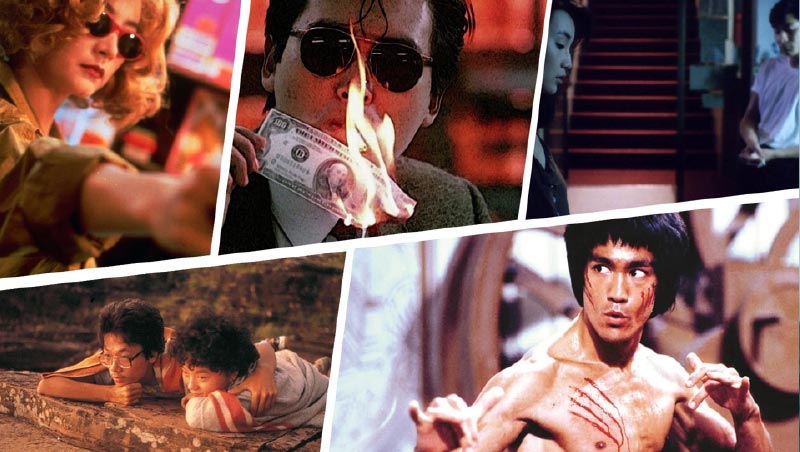As screenwriters, we are influenced by all the films and shows and stories we have ever seen and read throughout our lives. That’s inescapable. Most writers don’t talk much about their influences, but Quentin Tarantino does. He revels in them. Some critics have criticized him for that because, well because they are clueless. The way Tarantino uses, revitalizes, and updates his influences is part of what makes his films so unique and likable. He knows Hong Kong cinema inside out and cites Ringo Lam’s “City on Fire” as a springboard for “Pulp Fiction” saying flatly, “I jacked a bunch of stuff from it.”

Tarantino has also acknowledged the influence of French New Wave filmmakers like Jean Luc Godard who he says “revolutionized the form.”
Most screenwriting books and classes focus on American cinema and that’s what most of us talk about most of the time. The Academy Awards honors American and British (English Language) films. All the films from all the other countries in the world are relegated to a minor category called “Best International Feature Film.” So, we have the feeling that American films matter. The rest don’t.
But watch the original Avatar, a ground-breaking film that needed something fresh and exciting for its big final battle. What’s that crashing through the foliage? It’s the bad guy piloting a mobile battle suit. Every fan of Japanese anime instantly recognized this mecha from a thousand tokusatsu stories. James Cameron did not grow up watching anime, but he is a fan. He called Akira and Ghost in the Shell “the first truly adult animation films to reach a level of literary and visual excellence.” And he drew on his love of anime to give his film the explosive climax it needed.
Years before Cameron, Alfred Hitchcock was heavily influenced by German filmmaking. He wrote: “I’ve always believed that you can tell as much visually as you can with words. That’s what I learned from the Germans.”
And filmmakers from De Palma to Scorsese to Spielberg have acknowledged their influence from Russian writer-director, Sergei Eisenstein.
Eisentein’s Battleship Potempkin screened in 1925. The world of filmmaking has grown much larger since then. Inventive films are being produced in South America, Africa, the Middle East, and throughout Asia. Each region brings its own story-telling traditions and cultural influences. They often mix ideas from American films, with ideas of their own.
Western filmmakers who broaden their perspectives and tune into films from other cultures will have more colors on their color palettes, more moves, more ideas, more ways to look at a story and find innovative ways to develop it.
This has nothing to do with partisan politics, globalism, or any other ideology. It is a survival skill for writers. Today there are more international co-productions than ever before and there will be many more in the future. Your ability to adapt to understand and work with people of other cultures can be crucial for your success.
This means more than just watching the rare blockbuster from abroad (Parasite). There are many independent filmmakers doing exciting work. The production values of their films can’t compete with Hollywood, but their ideas are often forged in experiences that Western people just don’t have.

Examples:
- The Day I Lost My Shadow, a film that came from the writer’s experiences in the Syrian Civil War. It’s not a story about armies and battles, rather it tells about a mother trying to get a gas cannister so she can cook dinner for her child. The story structure is worth studying because it is effectively adapted to the subject. (Soudade Kaadan – 2018)
- Atlantique, a very different kind of ghost story based on the experiences of Senagalese refugees. It doesn’t follow the rules of the horror genre – not at all. (Mati Diop – 2019)

- Ixcanul portrays the lives of villagers in Guatemala. Much of the dialogue was improvised by the actors speaking in the local Kaqchikel language. (Jayro Bustamante – 2015)
When we delve into other cultures, interesting things happen artistically. It’s challenging and challenges make us stronger.
So, we want to learn from the great Western screenwriters. We must learn from them. Filmmakers like Christopher Nolan; TV showrunners like Shonda Rhimes; and animation creators like the teams at Pixar. They are titans. We gain great insights by studying them. But there are other creators around the world who we should be aware of as well. Many are young and lean with fewer resources and smaller budgets, but with exciting stories to tell and new ways to tell them. As screenwriters, if we tune in to these sources, adapt, and stay flexible, we will be better prepared to write our best stories and to be ready for opportunities, local and global, as they arise.
[by the ‘Tame Your Story’ staff.]


